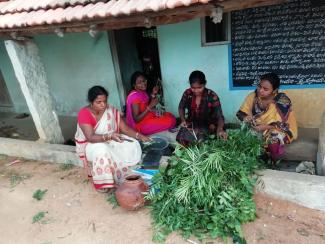Organic farming
Four wheels of Zero Budget Natural Farming

Why is organic farming so important for India and other developing countries?
Our planet is facing dramatic environmental change. We are now living in the sixth mass extinction, and it is a result of human activity. The Intergovernmental Panel on Climate Change (IPCC) warns that we must urgently change land-management patterns internationally (see Katja Dombrowski in Monitor section of D+C/E+Z e-paper 2019/09). Otherwise, average temperatures will rise more than 1.5 degrees – with dire consequences. Smallholder farmers and their families as well as landless agriculture workers are the least responsible for the climate crisis, but they face the gravest consequences. Rainfall is becoming ever more erratic. Dry spells and drought are worsening. Ground water is being depleted. Unseasonal rains and heavy storms are causes of concern too. Crop failure is becoming ever more likely. All countries therefore need solutions that ensure land is not degraded, soils are not eroded and farmers do not become distressed. One option is Zero Budget Natural Farming (ZBNF), our form of organic farming.
What exactly is ZBNF?
ZBNF promotes poly-cropping, the simultaneous cultivation of several useful plants. “Zero budget” means that the costs for the main crop are recovered from the other crops. “Zero budget” also means that this kind of “natural farming” does not require expensive external inputs. All inputs needed are generated on the farm itself. Our regenerative agriculture with holistic land-management practices relies on the powers of nature. ZBNF was pioneered by Subhash Palekar, a charismatic rural farmers’ leader who has been advocating this for more than 20 years. It also builds on the work of many other eminent persons. The four principles – or “wheels” as we say – are:
- Beejamrutham: microbial seed coating through cow urine and cow dung-based formulations.
- Jeevamrutham: enhancing soil microbiome through application of an inoculum made from uncontaminated soil, cow dung, cow urine and other local ingredients.
- Achhadana (mulching): keeping the ground covered by cover crops and crop residues all year.
- Waaphasa: build-up of soil humus with enhanced soil porosity and soil aeration.
Pest management is important too, of course, and ZBNF uses natural resources such as cow dung, cow urine, botanical extracts et cetera. Moreover, inter-cropping and poly-cropping, including trees, also help to manage pests. We do not use synthetic chemicals at all.
But wouldn’t high-tech high-yield approaches be more profitable?
Well, we must first define what that term means. Nature is actually a very sophisticated and highly productive system. The complex networks of microbial populations below the ground are drivers of plant growth. For instance, about 25,000 kilometres of fungal hyphae are estimated to exist in a mere cubic meter of healthy soil. The hyphae have an important role in the exchange of nutrients. If chemical fertilisers and pesticides are applied, these networks are destroyed. A real high-tech approach must therefore build on a proper understanding of nature. The farmers are experimenting all the time, their knowledge is evidence-based. Hence, I see respecting their knowledge as “high tech”. The guiding question is not just how much we can grow in one season but how much longer can we have green growth in a year.
Is your method feasible on all farms?
In Andhra Pradesh, we work with all types of farms – subsistence farms, small holdings and large farms. However, most of the 572,000 farmers enrolled in our ZBNF programme are subsistence farmers or smallholders with less than 0.8 hectares. Only 11 % have more than 1.6 hectares.
Can ZBNF feed India or indeed the world?
Yes, it can. Our experience shows that ZBNF crop yields do not decline over time. Mulching with a 365-day green cover actually intensifies farming in a sustainable way. The point is to keep even rain-fed lands covered with live crops all year long. By contrast, the current industrial agriculture system has undermined food security, not least because nutrition values have dramatically declined.
Have scientists tested the validity of your approach?
Well, in my eyes, the farmers themselves are the greatest researchers. They see season for season what works and what does not. However, we have also cooperated with academic research institutes:
- The Centre for Economic and Social Studies (CESS) in Hyderabad is conducting socio-economic impact assessments.
- The Nairobi-based World Agroforestry Centre (ICRAF) is evaluating the impact of ZBNF on soil fertility, water-holding capacity, biodiversity et cetera. They are also evaluating performance and impacts.
- Scientists from the University of Reading in the UK are studying the impacts of ZBNF on soils and crop growth.
- The Bangalore-based think tank
- C-STEP (Centre for the Study of Science, Technology and Policy) is assessing how ZBNF reduces water and energy consumption.
- The Delhi-based think tank CEEW (Council on Energy, Environment and Water) is checking what ZBNF does in regard to the UN Sustainable Development Goals (SDGs) as well as what this approach can contribute to reducing fertiliser-subsidy expenditure.
How do you reach out to new farmers?
To fully transition to ZBNF, a village needs support for up to seven years, and individual farmers require up to five years. To spread the information, we rely on community resource persons (CRPs). These men and women have made the transition, performed particularly well and have been trained to teach others. They typically coach other farmers in neighbouring villages, where, after two to three years, new pools of CRPs can be identified. This peer-to-peer approach is very effective. What also matters is that all field officers of the State Agriculture Department are trained in ZBNF and are held responsible for supporting the CRPs.
Why is the empowerment of rural women an important dimension of ZBNF?
Women do a large share of the farm work. They till the land, rear cattle and other ruminants. They contribute labour for all farm activities, including sowing, weeding, harvesting, watering et cetera. At the same time, they are agents of change. Teaching a woman is akin to teaching a family. Any farming discourse is incomplete unless men and women of the household are involved. Women’s self-help groups, moreover, are very important for reaching out to new farms. In rural Andhra, some 7.5 million women are organised in about 730,000 self-help groups (SHGs). They can now mobilise many more people. This movement started two decades ago, basically as savings and credit groups. They are well networked and campaign for social change, health issues, livelihoods et cetera. The SHGs and their federations have become a transformative force. To a very large extent, ZBNF fits their goals, and accordingly, they have become important promotors of our approach. Many of our CRPs belong to this network. They understand the negative implications of chemical food for the health of their families and the adverse effect agrochemicals have on the soil.
Vijay Kumar Thallam is an advisor to the Department of Agriculture and Cooperation of the State Government of Andhra Pradesh and is leading the implementation of the ZBNF programme in Andhra Pradesh.
vjthallam@gmail.com














